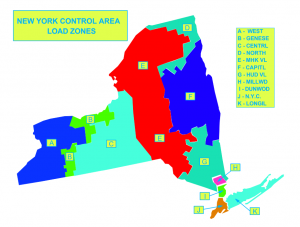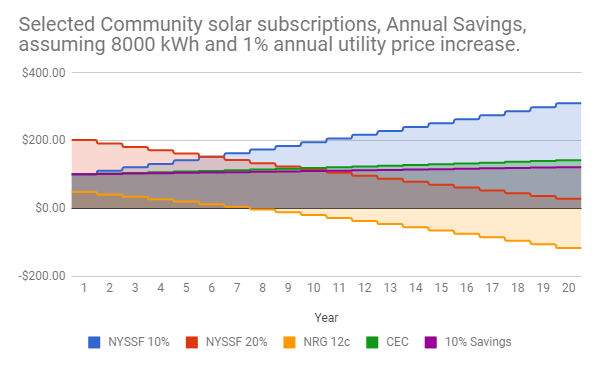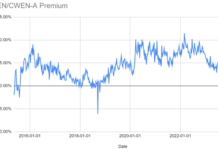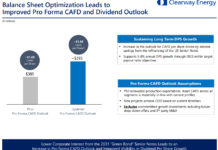by Tom Konrad Ph.D., CFA
An updated version of this article is available here.
After a painfully long wait, community solar (also called shared solar) is finally coming to New York state. After years of regulatory uncertainty, the state Public Services Commission (PSC) has put enough of the enabling regulations in place for a number of developers to move forward.
What is Community Solar?
A community solar installation is a large scale (typically 1 to 3 MW, or the size of about 150 to 800 residential solar installations) in which subscribers can sign up to lease or purchase a share of the production from the solar farm as a credit on their electric bill. Subscribers receive credits on their electricity bill for the energy produced by “their” portion of the larger solar farm.
Community solar is authorized by the state electricity regulator, which in New York is the Public Service Commission, so the details of how community solar works vary from state to state. In New York, where the rules for Community Solar generation are just being finalized, the details can even vary between different community solar farms. Some early farms were authorized under a different set of rules than is currently in effect. There are also differences in the terms that different developers are (or will be) offering, especially between purchase and lease models.
How Community Solar Works in New York
 To sign up for community solar, you have to be a customer of the same electric utility and in the same load zone (see map) as the community solar farm itself. When the community solar farm generates electricity, the utility compensates the farm with bill credits for the energy that the farm generates. These bill credits are distributed among the farm’s customers,
To sign up for community solar, you have to be a customer of the same electric utility and in the same load zone (see map) as the community solar farm itself. When the community solar farm generates electricity, the utility compensates the farm with bill credits for the energy that the farm generates. These bill credits are distributed among the farm’s customers,  reducing the amount the customer pays to the utility.
reducing the amount the customer pays to the utility.
How much the customer pays for these credits depends on the particular farm. Broadly speaking, there are two types of community solar. In the purchase model, the customer buys a number of panels and the associated share of the community solar farms’ output for the lifetime of the farm. The buyer may also commit to paying a low annual fee for operations and maintenance of the farm. Community Solar developers often refer to this as buying a specific number of panels, although the developer is unlikely to actually match particular panels to any particular buyer.
In a subscription model, the subscriber makes monthly payments. These monthly payments can be a percentage (most often 90%) of the value of the bill credit, or an agreed price per kWh. Subscriptions based on price per kWh usually start at a price below the current utility rate. Some keep a fixed price for the term of the subscription, while others have an annual escalator that increases that price by a small percentage every year. When writing about community solar customers in general, I will sometimes refer to both buyers/owners and subscribers as “customers.”
Both community solar subscriptions and purchased shares/panels are portable within the same utility territory and load zone if the customer moves. This is an important feature, since community solar agreements last for 20 years or more. They can also be transferred to another customer if the original customer moves out of the utility territory or load zone. Such transfers may come with a cost specified in the contract.
Some subscriptions may require an upfront payment. Many subscriptions require a credit check and a sufficient FICO score. Buyers are unlikely to to need a credit check because nearly all their payments are made up-front and their ongoing obligations are minimal.
All community solar developers will ask to see a recent electric utility bill before offering you an agreement. The bill lets them know if you are a qualified customer, and also to estimate how much community solar you will need.
Varying rules: Monetary and Volumetric Crediting
Due to a changing regulatory landscape and grandfathering, not all community solar farms operate under the same set of rules. For any one farm, it should be sufficient to understand how that particular farms works, but be aware that the details of how one community solar farm works do not necessarily apply to another. The most important difference is whether the farm operates under volmumetric vs. monetary crediting rules.
Volumetric crediting rules are most analogous to net metering with home solar. Here, the credits are for kWh usage, and credits can only be applied up to actual usage. With monetary crediting, the credits are counted in dollars and cents. These bill credits can be applied to the bill in any amount, and even reduce the entire electric bill to $0. Volumetric credits can never reduce utility fixed charges, but only apply to the portion of the electric bill based on total usage.
Monetary crediting has the advantage that the customer can offset the entire bill, not just the variable portion. In summer months, when solar production is highest, those credits need to be more than the entire bill in order to make up for low credits in winter. This can lead to the cost of the community solar subscription exceeding the electric savings for a few months in summer, while the savings will greatly exceed the cost in winter. This effect of shifting some costs to summer from winter may be an advantage for subscribers who face large winter heating bills, but it could come as a surprise to unprepared consumers. Community solar subscriptions under monetary crediting promise savings over the course of a whole year, not each and every month.
Volumetric crediting has the advantage that credits can only be applied to a bill if there is actual usage to offset, so the subscriber will have savings each and every month. The downside is that the savings will be limited to energy usage, and fixed monthly electric fees can never be offset.
Purchasing Community Solar
I am aware of two community solar developers offering panels for purchase. Local solar installer Hudson Solar is currently selling panels at the solar farm it is building in Rhinebeck. Other Hudson Valley farms are under development.
Hudson Solar is taking reservations now, and they expect the farm to start producing power in the first quarter of 2018. They offer shares as small as 3 panels (1080W generating an expected 1350 kWh a year) up to enough panels to produce energy equal to a year’s normal usage. These are available to anyone in Central Hudson’s territory in Zone G, which is most of the Hudson Valley. When you buy panels from Hudson Solar, they actually record the specific panel serial number and assign you a pro rata portion of the rest of the solar equipment on the farm.
Hudson Solar charges a higher price per panel for 3 or 4 panels. The extra cost makes this option financially unattractive, and customers with very small loads are likely to be better off with one of the community solar subscriptions described below. For larger installations, the financial returns are not nearly as good as the best rooftop solar installations, they are still quite attractive.
Renovus Solar has a project open to NYSEG customers Zone C. The farm itself is located in the Finger Lakes region. Buyers pay $2.09/W for a minimum of one kW, and the value of bill credits is in kWh allocated to the purchaser’s electric bill. There is a 3 cent per W annual operations and maintenance fee.
I get a 4 percent to 10 percent internal rate of return depending on my assumptions for both Hudson Solar and Renovus’ current offerings.
Delaware River Solar offers both purchase and subscription options in NYSEG Zone C, but did not respond to my interview request.
If you have the cash to invest, and especially if you expect electricity rates to rise, a community solar purchase is likely to be a good investment for electricity customers who pay federal income tax, and do not own a building with a roof suitable for solar. The precise returns will depend on the details of a particular project, and (most importantly) on future electricity prices. Prospective subscribers can value community solar subscriptions using the same methodology I described in my article Should I Sell My Mutual Fund to Go Solar?.
Risks: The biggest risk with a community solar purchase are that the buyer may not be able to recover the initial investment. This could happen if the buyer moves and is unable to find someone willing to buy the community solar share for its full value. It could also happen if the buyer’s electricity usage falls below then amount generated by the share, in which case some of its value will be wasted unless a buyer for the extra panels can be found.
Purchase Type Community Solar
| Developer |
Utility |
Zone(s) |
$/ annual kWh |
annual O&M |
Minimum |
Status |
| Hudson Solar | Central Hudson | G,H | $2.43 | 0.75 cents/W | 1.8kW (1-1.8kW at higher price) | Available Now |
| Renovus Solar | NYSEG | C | $1.69 | 3 cents/W | 1 kW | Available Now |
| Delaware River | NYSEG | C | unknown | unknown | unknown | unknown |
Community Solar Subscriptions
The vast majority of community solar available now or in the near future are subscriptions or Pay-As-You-Go (PAYG) model. In this case, the utility allocates bill credits to each subscriber calculated to come as close as possible to offset their electric bill over the course of a year without providing excess credits. The subscriber pays the solar farm operator directly for the bill credits at a predetermined price per kWh or discount.
One of the greatest advantages of all community solar subscriptions is that the subscriber does not have to be able to use tax credits in order to get the full financial benefits. Low income customers, nonprofits and government entities can sign up and get the same benefits as residential subscribers, as long as they are billed at the general service rate. The economics do not work for larger commercial meters (demand meters.)
Discount Type Subscriptions
My favorite type of community solar subscription has a very simple model: the subscriber gets a monthly bill credit from solar generation, sized to equal the subscriber’s electric bill over the course of the year. The subscriber in turn pays the community solar developer 90% of the value of the bill credit, saving 10% at no upfront cost and virtually risk-free.
In New York, Nexamp is offering subscriptions of this sort in the Hudson Valley. Both offer a 10% discount to utility rates. They have farms in both Central Hudson and Orange and Rockland territories which should be coming online in mid to late 2018 (depending on the utility and zone.)
For subscribers in NYSEG Zone C, BlueRock Solar is taking subscriptions for a community solar farm that is already built and should be online by the end of this year (2017). They have a fully-subscribed and operational farm in Millport, NY, and a farm in National Grid (Zone A) that should come online next spring. Although savings will come much sooner than for the others listed above, the discount offered is only 5%, not 10%. However, BlueRock’s subscriptions can be as short as one year (and up to three.) With a one year subscription, smaller savings that start 6 months sooner have some appeal compared to signing up for a community solar farm that may not start producing power until the second half of next year.
Unlike community solar purchases and some other types of subscriptions, the permanent discount minimizes risk for the subscriber, who will never end up paying more for electricity with this sort of subscription than without it. The typical short contract lengths or easy termination terms also reduce risk for the subscriber.
Discount Type Community Solar Subscriptions
| Developer |
Utilities |
Zone(s) |
Savings |
Status | Termination | Credit |
| Nexamp | Central Hudson,
Orange & Rockland, |
G,
G, |
10% | Taking reservations Savings start Summer 2018 |
No fee 90 day notice |
no credit check |
| BlueRock Solar | National Grid NYSEG |
A, C |
5% | Savings start Spring 2018 Savings by Dec 2017 |
1 to 3 year contracts | no credit check |
Risks: The only “downside” to this type of discounted subscription is that if electricity rates do rise rapidly, other types of community solar will save considerably more. Nexamp even protects subscribers from the risk that their electricity usage might change by adjusting each subscriber’s allocation every three months for the 20 year life of the contract. Subscribers can terminate Nexamp’s contract at no cost with 90 days notice. BlueRock offers subscribers a choice of short-term (one to three year) contracts, keeping the risk to subscribers low.
Price Per kWh Subscriptions
Many community solar subscriptions are offered at a set price per kWh. This price may be set at a specific cost per kWh or a set percentage below the current price for electricity from the utility. These contracts often have an annual escalator by which the price of the subscription increases every year, and usually require a credit check.
Price Per kWh Community Solar Subscriptions
| Developer |
Utility |
Zones |
Initial Price |
Escalator |
Termination Fee |
FICO Score |
| New York State Solar Farm | Central Hudson | G | 10% below utility rate | 0% | $300 | >650 |
| New York State Solar Farm | Central Hudson | G | 20% below utility rate | 2% | $300 | >650 |
| Clean Energy Collective | Con Ed, Central Hudson, Orange & Rockland |
I, J G G |
10% below utility rate | 0.9%; min 1c/kwh savings guarantee | Varies | >680 |
| Clearway Community Solar | Central Hudson Orange & Rockland |
G G |
12 cents Unknown |
1.75% Unknown |
Unknown | >700 |
| Delaware River Solar | NYSEG, RGE | ? | “approx 10% below utility rate” |
Unknown | Unknown | Unknown |
Risks: These subscriptions can generate large savings if the price of electricity from the utility rises faster than the the price of the subscription. The trade-off is that it is possible for a subscriber to end up paying more for the community solar credits than they are worth. This can happen if the price for electricity from the utility falls (as it did for many NY utilities between 2014 and 2017), or if it fails to rise as quickly as the price of the community solar subscription. To protect the community solar farm operator from customers defecting in droves if the subscription price exceeds the utility price, these types of subscriptions typically come with a cost for terminating the agreement. They can usually be transferred for free if another qualified and willing subscriber can be found, but willing subscribers will not be available unless the contract is generating savings and looks likely to continue to do so.
The overall risk inherent in a this type of subscription is limited to the greater of the termination fee and the difference between the subscription cost and the cost of electricity for the future term of the contract. Since termination fees are typically a few hundred dollars, this risk may be worth taking, especially for customers with large electricity bills for whom the potential savings are large compared to the termination fee.
Of the developers listed above, the only one I was able to talk to in depth was New York State Solar Farm (NYSSF) a solar installer that has been planning a community solar farm in Gardiner, NY for years. Their farm is being financed by SunPower (SPWR) and use SunPower panels, but due to a moratorium on large scale solar in the Town of Gardiner, it will be unlikely to start producing power until the second half of 2018. When they do start selling subscriptions, they will require a credit check and a minimum FICO score of 650. When NYSSF finally gets its farm built, I expect that its fixed price subscriptions that start 10% below the utility rate will be the most attractive available in Central Hudson territory.
Clean Energy Collective (CEC) will soon be offering only slightly less attractive contracts in Central Hudson, Con Ed, and Orange & Rockland territories. These start at 10% below the utility rate, and have a modest 0.9% price escalator. Price escalation is capped to guarantee minimum savings of 1 cent per kWh.
In contrast Clearway Community Solar (NRG) has been much more active, and has even been sending people door to door in some towns in their coverage area. The company did not initially respond to my press inquiry, so I called their sales hotline to ask some questions as a potential customers. After answering some of my questions, I was referred to the company’s Senior Director of External Communications. Although he agreed to consider my questions by email, he did not get back to me with answers after a full week. I consider NRG’s use of door-to-door salesmen as well as the company’s lack of responsiveness to press inquiries to be red flags, so I would caution subscribers against signing up for NRG’s community solar offering without carefully reading the contract and making sure that they understand the details of what they are signing up for.
Delaware River Solar did not respond to my interview request, but their website suggests that they offer subscriptions with an “approximately 10%” discount to utility rates for subscribers in NYSEG and RGE territories. While these might actually be discount type subscriptions (as opposed to set price), the “approximately” leads me to believe that it’s likely a discount type subscription starting at 10% below the utility rate, most likely with an escalator.
To illustrate the potential risks and benefits of this sort of contract, I simulated what would happen over the 20 year life of these contracts for a household using 8000 kWh a year, in a scenario where utility rates increase only slowly (at 1% a year.) In this case, the NRG Community Solar customers (yellow bars) would see all their savings vanish by year 8, after which they would begin owing NRG more than they were saving on their utility bill. Both Types of NYSSF customers would see savings for the entire 20 years, but the customers who opted for the larger initial discount (red bars) with an escalator end up saving much less than the customers who opted for a fixed rate for the life of the plan (blue). I also included a 10% savings plan like the ones offered by Nexamp and Clean Energy Collective for comparison. These comparisons are based on Central Hudson’s average electricity price of 12.6 cents per kWh (combined energy and delivery charges) over the last 12 months at the time of this writing.
Model Annual Savings From Various Community Solar Subscriptions

Another way to compare set price contracts with fixed escalators is to look at what the set price will be halfway through the contract term, which will usually be ten years. Here is how the above contracts compare after 10 years, using the same 12.6 cent per kWh utility price:
| Subscription |
NYSSF, 10% below | NYSSF, 20% below | NRG | CEC |
| ¢/kWh after 10 years |
11.34¢ | 12.35¢ | 14.03¢ | 12.29¢ |
Note that discount type subscriptions are not directly comparable to these because their future prices depend on what happens with utility rates.
Summary
Community Solar is a great opportunity to save a little money on your electric bill while helping the environment. While the savings are not as large as they can be for a homeowner with a suitable roof for solar, they are open to everyone. All you need is an electric bill. It’s also easy for nonprofits, municipalities, and small businesses to participate.
Only large businesses with demand meters, and people who already have solar are ineligible.
Community solar is an especially good opportunity for people without a lot of income, nonprofits, and municipalities. Anyone who cannot use federal or state tax credits should look at community solar first. The (non-taxable) Town of Marbletown just signed up five of its buildings.
Like rooftop solar, community solar agreements vary widely. You can buy a few panels in a community solar farm outright, or you can sign up for subscriptions.
Community solar purchases provide the greatest long term savings, but are only practical for people who can take the federal investment tax credit and are able to pay for their solar up-front.
The next greatest potential savings come from subscriptions that come at a set price per kWh. This type of contract can be a double-edged sword: promised savings can vanish or even turn into extra costs if the contract price includes a large price escalator. Contracts that offer a fixed price for the life of the solar farm are much safer and will lead to the greatest savings over the life of the solar farm. If contracts have an escalator, the smaller the escalator, the better. One fair way to compare such contracts is to look at what the fixed price will be halfway through the contract term. Clean Energy Collective’s 1 cent per kWh savings guarantee greatly alleviates this potential problem.
The simplest and safest way to participate in community solar is the discount type subscription. While lacking the large long term potential savings of the best set-price per kWh subscriptions or purchases, the subscriber can be confident that there will be savings of five to ten percent on their electric bill each year, every year. This certainty of savings also adds flexibility: it should be easy to find someone to take over your subscription if you move or your electricity usage falls. Developers with this sort of subscription will almost inevitably have waiting lists.
Conclusion
Community solar is a great and long awaited opportunity for almost everyone in New York who cannot do rooftop solar for whatever reason.
Look for a discount type solar subscription, or one that offers a fixed price that starts below the current utility price with as small a price escalator as possible, but sign up as quickly as you can if you find one. These types of subscriptions tend to sell out quickly, especially since community solar farms are currently limited in size to 2 MW, which is only enough for about 300 subscriptions.
If you can use tax credits, can afford it and can’t put solar on your roof, buying community solar panels is a great option. These have the advantage of the greatest long term saving, and the farms don’t tend to sell out quickly because of the high up-front cost.









excellent analysis
Quesstion: I cannot find any details on Community Solar for New York State Solar Farm, which is listed here as having 2 Community Solar Subscription models. Update?
NYSSF is very early stage and not yet selling subscriptions. They’ve been delayed because their project is in Gardiner, NY which passed a moratorium on solar development which should end this spring.
Great article.